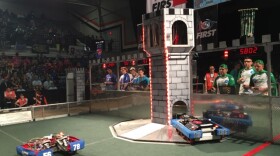Imagine what it would be like to be able to shrink so small you could travel through the human blood stream, or even so small you could explore a hydrogen atom.
Inside of a engineering building at UC Santa Barbara, there’s a giant experimental sphere, the AlloSphere, which allows researchers to visualize the very tiny on a huge scale.
As you walk onto a metal bridge into the center of the room, it feels like you are in a huge cavern, with what appear to be 3-D stalactites and stalagmites. What you are actually surrounded by is a real image of a human brain created from an MRI.
JoAnn Kuchera-Morin is a professor of media arts, technology and music at UCSB. She’s Director of the AlloSphere Research Facility. She says it’s a creation which makes sense.
Massive supercomputers can crunch almost unimaginable amounts of data to create images, but researchers then see the results on the same type of screen that’s on your laptop.
The AlloSphere brings the images to life on a huge scale, to allow people to explore things in a previously impossible way. It’s also interactive, so a researcher can use a hand controller to explore parts of the structures.
The potential uses are wide reaching.
One idea is that a doctor at the AlloSphere could remotely work with a doctor with a patient, with the technology being used to literally get inside of an MRI to find a medical problem. At the same time, it can be used to explore nature, or, even as an artistic medium.
The AlloSphere is the result of Kuchera-Morin’s more than three decades of work, which started as a pre-internet project to connect musicians in real time.
Dennis Adderton is the AlloSphere’s Technical Director. He describes the AlloSphere as a 2,000 square foot, three story suspended ball, with a metal observation walkway on the second floor. It has dozens of projectors and a multi-track sound system.
The original AlloSphere is closed to the public.
But a scaled-down version of it is now being created to be one of the showcase interactive exhibits in a new museum under construction in Santa Barbara.
Steve Hinkley is the President and CEO of MOXI, The Wolf Museum of Exploration and Innovation.
He says they will have a version of the AlloSphere which will allow the public to experience the technology. Plans call for the 17,000 square foot museum to open around the end of the year, as supporters work to raise the final three million dollars for the $25 million dollar project.
Kuchera-Morin says it’s exciting to be be able to share the unique technology with the community. She believes that virtual reality technology is going to catch on like wildfire in the next 15 years, but that it will be much more than a video game advancement, it will be an important scientific research tool.





